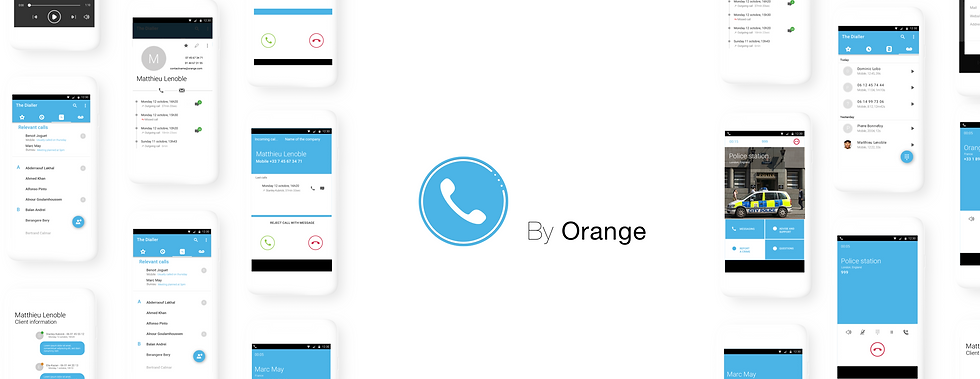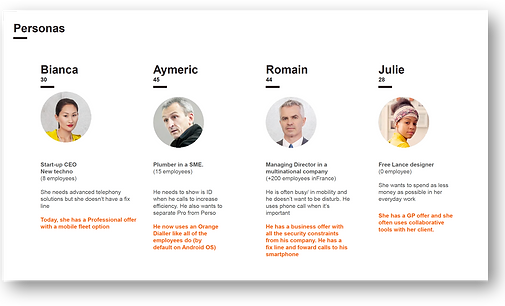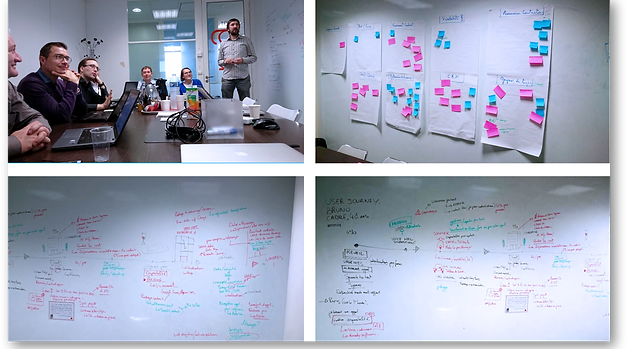Sophie Majecki
Work
Work
Work
UX Designer
Currently working at Ipsen and previously at Orange, XDLab Studio, I have collaborated with incredibly talented people across different companies and countries.

Designing features for Orange
B2B Telephone App
Year: 2017
Role: UX/UI Designer
Team: B2B Design Team, Orange
Scope: User research, ideation workshops, journey mapping, prototyping, and initial designs
Introduction
Telephone was a project to reimagine Orange’s telephony experience for SMEs and business users. My goal was to design forward-looking features that enabled entrepreneurs to manage calls, voicemails, and contacts more efficiently — improving mobile workflows and empowering business decision-making.
Targeting small and medium-sized enterprises, Orange wanted to embed business-oriented features directly into the smartphone dialler while keeping the experience intuitive for all users.
The features I helped define included:
-
Smart spam and fraud protection, with pre-call alerts and reporting
-
Professional caller identification for unsaved contacts
-
Call cost visibility on-screen
-
Quick access to emergency numbers
-
Personalisation (themes, ringtones)
-
Simplified dual-SIM management
My role as UX/UI Designer included conducting user research, leading workshops, creating wireframes and designing high-fidelity interfaces for the app's long-term vision. I collaborated closely with the B2B design team, including a senior product designer.
Framing: competitive research and intervews
I analysed existing telephony apps for entrepreneurs to identify what works well and where gaps exist.
Findings:
-
Need for smarter call and contact management – Users wanted organized phonebooks, flexible scheduling, and multiple ways to place calls efficiently.
-
Partial alignment with user journeys – Most apps offered general features, but they didn’t fully match how SMEs actually manage calls and business communication.
-
Opportunity for contextual and actionable features – Users expected apps to adapt to their workflow, helping them stay available, follow up efficiently, and save time in daily operations.
Insight: SMEs increasingly rely on apps to manage availability, prioritise communication, and streamline follow-up, highlighting opportunities for a telephony app that truly fits their business needs.

Guerilla interviews
« The desk phones are for the bills, they are old and not practical things to use. We have phone calls all the time (frustrated)»
Espace Murit, Motorcycle dealer, Paris
« If I am at a client doorstep and don't have the door code, I call them anonymously to not share my personal phone number » Mobalpa, Homeware, Paris
« We use our mobile phones only, we have a desk phone at the agency that transfers calls directly to our boss's mobile phone »
Loft roquette, Event Agency, Paris
I conducted user research with 30 SMEs across four French cities (Chatillon, Montrouge, Strasbourg, and Paris) to gain qualitative insights into their telephony needs. The goal was to understand what drives SMEs in managing calls and communication and identify improvements with the highest impact on their workflows and start designing the features.
Methodology:
-
Semi-structured interviews exploring professional context, customer relationships, business activities, and use of professional phone numbers.
-
Open-ended discussions about potential new features, allowing participants to suggest ideas and priorities.
Outcome:
These interviews provided rich qualitative insights and verbatim feedback, which informed feature ideation, prioritization, and prototyping, ensuring that the new app features addressed real user needs.
Analysing
Based on 30+ interviews across four cities and prior design research, we developed four primary personas representing different SME user types.
These personas captured:
-
Demographics: name, age, business size, and context
-
Business needs and objectives
-
Pain points and habits
The personas were referenced throughout the product development process, helping the team understand user differences and guide design decisions. They were especially valuable during the ideation phase, ensuring proposed features addressed real user needs.


We mapped each persona’s steps and interactions to identify friction points, uncover opportunities, and focus on their most important goals.
-
Inputs: semi-structured interviews, field observations, and persona data
-
Outputs: detailed journey maps highlighting actions, objectives, motivations, and emotions
This approach allowed us to:
-
Understand the full user workflow from start to finish
-
Identify pain points and successful interactions
-
Inform feature design and prioritization with a user-centered perspective
Exploration and design
Following multiple workshops and collaborative sessions, I translated research insights into high-fidelity feature designs. Key features selected for prototyping and testing included:
-
Visual IVR – Replaces traditional audio menus with an interactive on-screen interface, allowing users to complete tasks like paying a bill or contacting support visually, saving time and reducing frustration.
-
Voicemail Transcription – Converts voice messages into text, enabling users to read and act on messages anytime. The app also recognizes dates, names, and locations, suggesting actionable steps such as scheduling events or saving contact details.
-
Relevant Contacts – Predictively surfaces contacts based on user behavior. For example, if a user calls the same contact every Monday morning, the app proactively suggests interactions, streamlining routine workflows.
-
Business Phonebook – Provides rich, collaborative contact cards including address, email, call history, and team notes. Teams can track call activity, share comments, and maintain transparency, supporting more efficient communication within SMEs.

After creating the wireframes and validation from the all team, I started designing the screen for the app using the graphical guidelines. The app has been designed only for mobile device.
To summarise
After validating feature concepts through workshops and research, I translated ideas into wireframes and interactive prototypes to test flows, interactions, and usability.
-
Wireframing & Prototyping – Created low- to mid-fidelity wireframes to quickly iterate and refine user flows. Interactive prototypes were tested internally to share with engineers and stakeholders.
-
High-Fidelity UI Design – Designed polished screens following Orange’s B2B design guidelines, focusing on clarity, consistency, and mobile-first experience.
-
Collaboration & Feedback – Worked closely with the B2B design team and senior product designer, iterating on feedback to ensure designs were both usable and aligned with business goals.
4
Sprints
(To include research, wireframes & interactive prototypes to test)
30
SMEs interviewed on site
(Moderated interviews from different industries)
4
B2B Personae created
9
Successful launch
(French, English, Catalan, Spanish, Flemish, Polish, Romanian, Russian, Slovakian)
+50 000
Downloads since 2017
(Android platform & IOS)
4,6/5
Rated on Android stores
( 4,5/5 on Apple Stores)
The Telephone project successfully translated research insights into actionable features that can improve the SME user experience, it helped answering to our user needs with validation that these new business features such as Visual IVR, voicemail transcription, and relevant contacts, would be valuable to be integrated into the app’s second version based on research.
Strengthening alignment between user needs, product strategy, and business objectives, I really enjoyed having ownership from research and ideation to high-fidelity design, positioning the app as a future-ready telephony solution for SMEs















